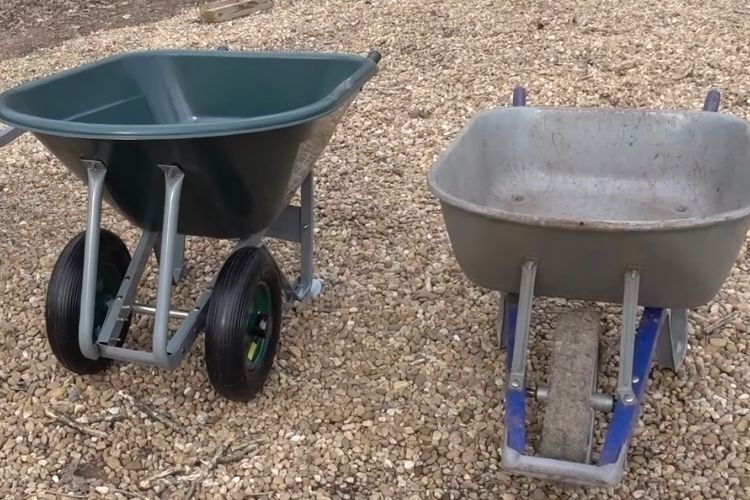Choosing the right wheelbarrow can be tough. There are many factors to think about when making this decision, and they all will affect how you use your wheelbarrow in the future.
At some point, most gardeners will find that they need a wheelbarrow to accomplish certain gardening tasks. Wheelbarrows are used for a variety of things, such as moving rocks, mulch, or compost into the garden, moving trees or large shrubs from one place to another, hauling bricks, disposing of garden waste, or even mixing concrete or fertilizer. Not all wheelbarrows are the same, however. The type of wheelbarrow you should buy depends on the tasks you need it for. If you’re looking for a few pointers on what types of wheelbarrows are out there, read on!
Use wheelbarrows in gardens
With so many varieties available, it’s important to choose a wheelbarrow that fits your gardening needs. Basically, there are two types of wheelbarrows to choose from: Steel or plastic.
Steel wheelbarrow buckets can carry more weight, but they can rust and are harder to manage. Steel wheelbarrows are used for heavy jobs like rocks, stones, or large plants.
Plastic wheelbarrows are lighter and usually less expensive than steel but can crack due to excessive weight, extreme temperature changes, or improper handling. Plastic wheelbarrows are used for moving mulch, compost, garden waste, and smaller plants. Plastic is also better for mixing things like concrete or fertilizer and transporting cow manure, as these things can damage the steel.
There are also wheelbarrows that have different capacities or volumes. In the US, these are usually available in the 2-square foot to 6-square foot capacities, with 3-square feet being the most common. These wheelbarrows can also be labeled to carry 300-500 lbs. Elsewhere, wheelbarrows are often sold as 60-120 L, with 100 L being the most common.
Just because a wheelbarrow label says it can hold 500 lbs doesn’t mean you have to fill it to the brim with rocks or stones. How much weight you put in your wheelbarrow depends on your own strength. While wheelbarrows are designed to move and drop heavy items more easily, a wheelbarrow full of rocks or other heavy materials is too heavy for many people to handle.
Use wheelbarrows in construction
The right wheelbarrow can make construction projects much easier. Wheelbarrows are often used in construction to help transport materials like dirt, stones, and sand from one place to another. This is particularly true for larger construction sites that need several tons of material moved around at any given time. These types of wheelbarrows will be able to carry large amounts of weight with ease thanks to their strong metal frames and sturdy wheels. The best wheelbarrows for these purposes have handles designed specifically for easy gripping so you don’t feel the strain on your arms as you lift heavy loads up off the ground level or onto a higher surface.
The three main types of wheelbarrows that you can choose from including the standard, concrete, and garden varieties. The first type is a very popular choice for large projects because it’s made to be lightweight yet durable enough to carry tons of weight. Wheelbarrow concrete is also ideal for transporting heavy items but they tend to be heavier and less maneuverable than the standard variety. Garden ones, on the other hand, are lighter and more compact making them perfect for transferring plant materials or soil from one location to another without doing too much damage to the plant’s roots in the process.
How to choose a wheelbarrow
Some other considerations when choosing a wheelbarrow are the handles and wheel(s). When you hear “wheelbarrow,” you probably picture the classic wheelbarrow with two straight handles, with one wheel centered in front and two supports evenly spaced in the back. However, newer types of wheelbarrows may have ergonomic bar handles and/or two wheels.
Wheelbarrows with one wheel are easier to empty and maneuver, but they can also tip over very easily while turning, dumping, or from unbalanced loads. Wheelbarrows with two wheels are less tippy but can be harder to turn and empty. Wheels are also available as regular air-filled wheels, like a bicycle or solid rubber wheels. Solid rubber wheels do not flatten or pop like air-filled wheels, but they also do not have the shock absorption of air-filled wheels, making them harder to use on uneven terrain.
The classic wheelbarrow with two handles is designed for good leverage. These handles are usually plastic, metal, or wood. Plastic handles can break from too much weight. Metal handles can become extremely hot from long periods in the sun. Wood handles can break and splinter from too much weather. Two wheelbarrows can also require a lot of upper body strength and cause shoulder, arm, and back pain. Ergonomic handles are often handlebar grips, like a lawnmower. These handles are designed to put less strain on the upper arms, but they can actually cause more back pain because they have less leverage when lowering the load.
Special slim-line wheelbarrows are also available for use in small, tight spaces. There are also folding canvas wheelbarrows available for easy storage. Of course, these canvas wheelbarrows may not have much weight.
Take your time to choose the best wheelbarrow for your needs. There are pros and cons to the different types of wheelbarrows, so base your choice on what seems easiest for you to use. To extend the life of your wheelbarrow, always store it in a garage or shed between uses.
